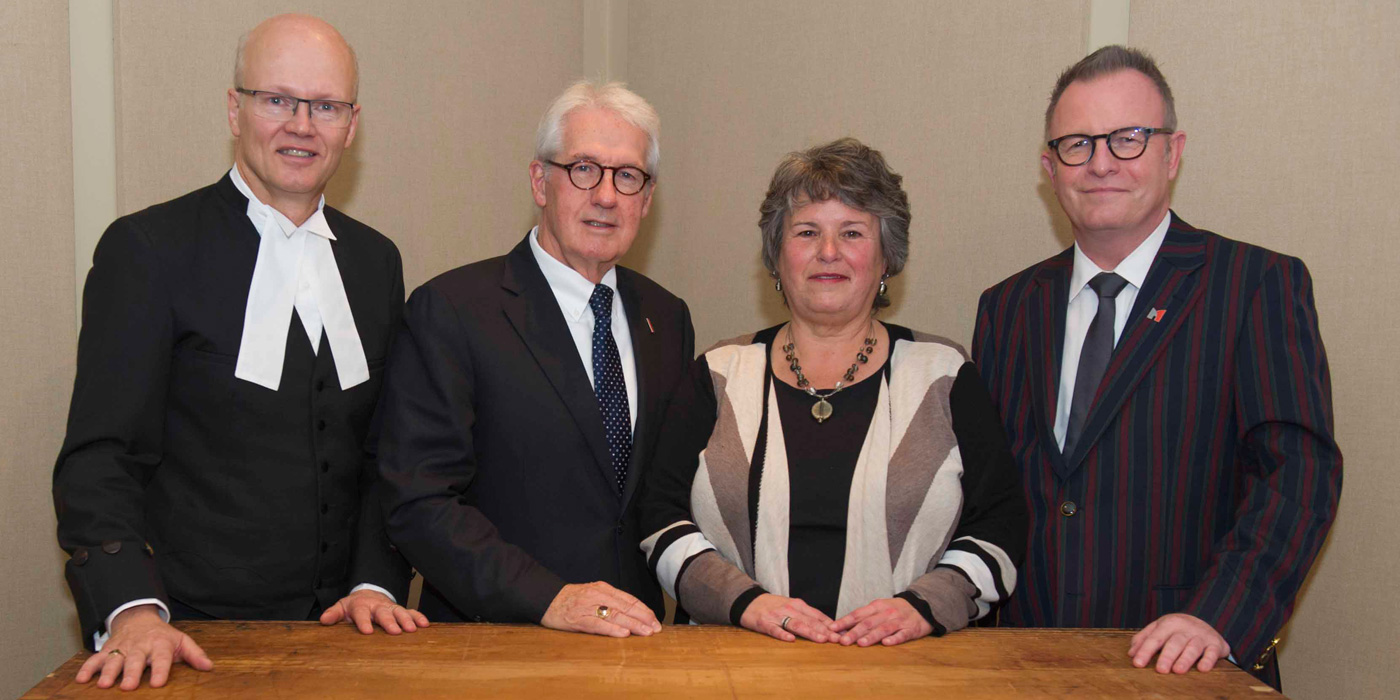William James Roué Collection Finds Perpetual Home at Canadian Museum of History
On October 27, 2016, it was announced that the William James Roué Collection had found its perpetual home at the Canadian Museum of History in Gatineau, Quebec. This amazing complex (partially pictured below) sits on the banks of the Ottawa River directly across from Parliament Hill in Ottawa. The Museum has the ability to conserve and preserve the 3D items as well as the nearly 800 vessel design drawings and textual materials in the Collection. The official announcement as well as supporting documents and event photos follow…

The Canadian Museum of History is proud to have acquired a significant collection of artifacts owned and created by William James Roué, one of Canada’s most renowned naval architects and designer of the iconic schooner Bluenose.
 Consisting of three-dimensional artifacts and archival material, the collection celebrates Roué’s remarkable career and diverse skills. The acquisition contributes to the study of 20th-century naval architecture and the history of wooden ship and boat building in Atlantic Canada. The collection has been recently designated by the Canadian Cultural Property Export Review Board as being of “outstanding significance and national importance.”
Consisting of three-dimensional artifacts and archival material, the collection celebrates Roué’s remarkable career and diverse skills. The acquisition contributes to the study of 20th-century naval architecture and the history of wooden ship and boat building in Atlantic Canada. The collection has been recently designated by the Canadian Cultural Property Export Review Board as being of “outstanding significance and national importance.”
The artifacts and archival material have remained in Roué’s family since his death in 1970 and come to the Museum from his great-granddaughter, Joan Roué.
“The Canadian Museum of History is very pleased to acquire this significant collection,” said Mark O’Neill, President and Chief Executive Officer of the Museum. “It is a very important piece of national history, and we are grateful to the Roué family for safeguarding these objects and giving us the opportunity to add them to the National Collection, where they will be shared with Canadians and preserved for future generations.”
“We are grateful for the respect shown to William James Roué by those at the Canadian Museum of History throughout this process and are confident it is the right place for the Collection to find its permanent home,” said Joan Roué, great-granddaughter of W. J. Roué. “Part of the process for us was to find a place where a design portfolio of this magnitude could be properly conserved and still be available to the public. The Canadian Museum of History is that place. This will help preserve my great-grandfather’s legacy as well as that of Bluenose on a national level.”

Speakers at the announcement included (left to right): The Honourable Geoff Regan, Speaker of the House of Commons & MP for Halifax West; The Honourable Wilfred P. Moore, Senator; Joan Roué, great-granddaughter; Mark O’Neill, President & CEO Canadian Museum of History. (Photo – Canadian Museum of History)
William James Roué is most famous for designing Bluenose, the schooner that first won the International Fishermen’s Trophy in 1921 and continued winning races throughout the 1920s and 1930s, earning a place in the history and popular imagery of Nova Scotia and becoming a symbol of Canada, both at home and abroad.
Roué’s skill as an architect extended beyond his Bluenose design. He constantly proved his capabilities as a naval architect, staying abreast with developments in the field and displaying talent for a diverse assortment of vessels. His designs ranged from small pleasure craft to larger racing sailboats, including Little Haligonian and Norseman, as well as the Bluenose Class sloops still built and sailed today. He also designed more utilitarian vessels, such as ferries and fishing boats for the Nova Scotia government and, during the Second Word War, invented and designed sectional barges for the British Ministry of War Transport.
Three-dimensional artifacts in the collection include Roué’s drawing table, half-hull models of vessels he designed and an engraved pocket watch presented to him after Bluenose’s historic 1921 victory. Archival material consists of plans and drawings for vessels as well as vessel specifications, client communications and more. In addition to the drawings for Bluenose, there are approximately 150 other designs by Roué, ranging from his first boat — launched in 1909 — to work undertaken in the late 1950s.
Some of the objects in the collection will be displayed in the Canadian History Hall, the Museum’s new signature gallery opening on July 1, 2017, which will incorporate the story of Bluenose and William James Roué. The Museum will also present a display on William Roué, as well as a virtual exhibition on its website. These events are being planned to help highlight the 100th anniversary of Bluenose in 2021.
Located on the shores of the Ottawa River in Gatineau, Quebec, the Canadian Museum of History attracts over 1.2 million visitors each year. The Museum’s principal role is to enhance Canadians’ knowledge, understanding and appreciation of the events, experiences, people and objects that have shaped Canada’s history and identity, as well as to enhance Canadians’ awareness of world history and culture. Work of the Canadian Museum of History is made possible in part through financial support of the Government of Canada.
It is important to note that, while the tangible pieces of the Collection are at the Canadian Museum of History, the Intellectual Property Rights remain with the Roué family. The design drawings can be viewed at the Museum but they will require written permission in order to provide copies; therefore, those wishing to acquire copies MUST complete our Application for Use/Reproduction.
photos – Canadian Museum of History – used with permission
source – Canadian Museum of History
The William James Roué Collection comprises three-dimensional artifacts and archival material created or acquired by Roué. The collection contributes substantially to our knowledge of Roué’s diverse skills as a naval architect. Moreover, it is of significant regional and national importance as it furthers our knowledge of the history of wooden ship and boat building in Atlantic Canada, presents the region’s multi-faceted relationship with the ocean and helps highlight the place that Bluenose occupies in the popular imagery and identity of both Nova Scotia and Canada.
The Objects
There are approximately 30 three-dimensional artifacts in this collection, including drafting tools and furnishings from Roué’s office, such as his drawing table and drawing and measuring tools. Other artifacts include tools used during his frequent visits to shipyards to review construction, half-hull models of vessels he designed, one of the first model hulls he built as a boy, his home office sign, a stopwatch used to time sailboats or to consult when racing and an engraved pocket watch presented to him by the citizens of Dartmouth after Bluenose’s historic victory in the 1921 International Fishermen’s Trophy race.
The Plans
The archival material includes 791 plans and drawings of vessels. In addition to the plans for Bluenose, there are approximately 150 other designs by Roué, ranging from his first boat — launched in 1909 — to work undertaken in the late 1950s. They demonstrate the wide range of the naval architect’s designs, from pleasure and racing craft to more utilitarian vessels like ferries, fishing boats and barges. The collection also contains textual material, such as specifications for a number of designs, correspondence with clients and personal records.
The Significance of the Collection
This collection not only reveals a tremendous amount about Roué’s remarkable career and diverse skills; it also discloses a great deal about 20th century naval architecture and wooden boat building in general. The drawing tools, office furniture and equipment are typical of the items naval architects of the time would have used. The plans and drawings are also characteristic of the era, as is the correspondence between Roué, his clients and boat builders or suppliers.
This collection is intimately linked to the history of the design, building and use of wooden vessels in Atlantic Canada and to that area’s relationship with the ocean. The wide range of Roué’s designs reveals the many ways in which Canadians have interacted with the water, be it for transportation, commerce or recreation. Finally, the collection also tells stories about regional and national identity, as one of its key elements — Bluenose — continues to hold a place in the history and popular imagery of both Nova Scotia and Canada.
source – Canadian Museum of History
William James Roué (1879–1970) is one of Canada’s most prominent naval architects. He is best known for designing the iconic schooner Bluenose, but his accomplishments cover a wide range of vessels. His career, which spanned more than 50 years, is intimately linked to the history of wooden ship and boat building in Canada during the 20th century.
Early Career
Roué was largely self-taught. An early fascination with boats led to extensive reading, designing and experimenting with model boats. After quitting school at the age of 17, following a dispute with a teacher over nautical nomenclature, he worked as a grocery clerk before joining the family soft-drink firm. He took night classes in mechanical drafting at the Victoria School of Art and Design (now Nova Scotia College of Art and Design University) to acquire the drafting skills necessary to become a naval architect. Roué also spent considerable time at the Royal Nova Scotia Yacht Squadron, where he crewed on members’ boats and studied in the clubhouse library. As soon as he was old enough to join, he spent $10 of his $100 annual salary on a membership.
In the following years, Roué divided his time between the soft-drink firm and his work as a naval architect. It was during this period that he was commissioned to design Bluenose, a ship that would become Canada’s most beloved schooner and Roué’s most famous accomplishment.
Bluenose
The International Fishermen’s Trophy was a competition between working fishing schooners from Lunenburg, Nova Scotia and Gloucester, Massachusetts. After the Americans won the initial race in 1920, Roué was commissioned by the Canadian committee to design a schooner for the following year’s race. Bluenose won the trophy in 1921 and continued its racing success throughout the 1920s and 1930s, winning the International Fishermen’s Trophy race a total of five times.
After Bluenose
The success of Bluenose opened many doors for Roué. He sold the family soft-drink firm in 1929 and took public and private commissions from across Canada and the United States. He did not simply ride on the success of Bluenose, however. He constantly proved his capabilities as a naval architect, staying abreast of developments in the field and displaying talent for designing a diverse assortment of vessels. His designs ranged from small pleasure craft to larger racing sailboats to more utilitarian vessels, including ferries and fishing boats for the Nova Scotia government and, during the Second Word War, sectional barges for the British Ministry of War Transport.
Roué died in 1970 at the age of 90. His career spanned more than 50 years and included over 200 designs. His contributions as a naval architect have been recognized in numerous ways, including through his induction into Canada’s Sports Hall of Fame and the Nova Scotia Sports Hall of Fame, the long-time presence of Bluenose on the Canadian dime and being featured on a Canada Post commemorative stamp in 1998.
Related